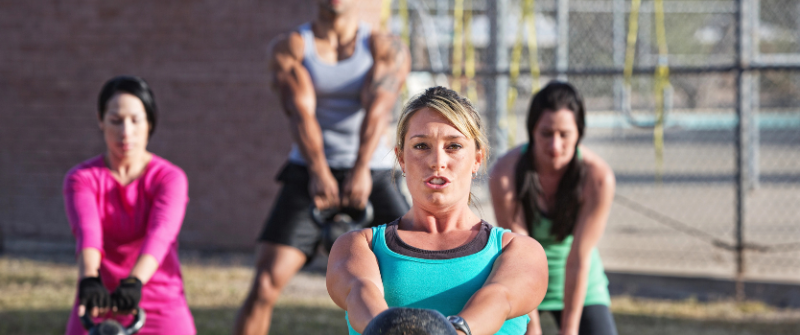
- by NEXO Team
- August 4, 2025
Functional training focuses on movements that mimic everyday actions, such as squatting, lifting, and rotating, to build strength, mobility, and real-world performance. Its accessibility and scalability make it a popular option for both beginners and seasoned athletes, especially in CrossFit-style gyms. However, the combination of dynamic movements, varied equipment, and high-intensity programming presents some unique challenges. From kettlebell swings to sled pushes, every element of functional training carries its own risk profile. How prepared are your trainers and clients?
Understanding Functional Training Risks
Functional training challenges the body in ways that machine-based workouts don’t, which also means it carries a different set of risks. Movements that rely on free weights or bodyweight demand more control, balance, and coordination, especially during high-intensity sessions. A minor breakdown in form can cause an injury, and this risk only increases with fatigue.
Kettlebell training risks, in particular, often stem from improper technique or a lack of supervision. In group settings, fast-paced circuits and limited space can create opportunities for collisions or missed cues. These are the kinds of scenarios that highlight the need for functional training insurance and a clear risk assessment for functional fitness and CrossFit gyms. Each type of movement and piece of equipment comes with a specific risk profile, and understanding these details is the first step in reducing liability.
Risk Profile: Kettlebell Training
Common Exercises
Kettlebell training is a staple in many functional fitness programs, and moves like swings, snatches, cleans, and Turkish get-ups are frequently used to develop power, coordination, and stability. You'll find them in both group settings and individualized CrossFit-style programming.
Risks
- Poor form can lead to back, shoulder, or wrist injuries
- Dropped weights can cause foot or floor damage
- Fatigue increases the likelihood of injury
Tips to Reduce Risk
Kettlebell training risks can often be avoided with clear instruction and consistent supervision. Coaches should focus on technique before increasing weight and stay alert to signs of fatigue during longer sessions. Scaled options help limit strain, especially for beginners or those returning after time off.
Fitness instructor insurance helps address the liability risks of functional fitness training, and a solid risk assessment supports kettlebell safety and injury prevention for both coaches and clients.
Also Read: Mastering Functional Fitness: Essential Benefits and Strategies for a Healthier You
Risk Profile: Turf Work & Sled Drills
Common Exercises
Turf zones are often used for high-intensity drills that target speed, power, and agility. Sled pushes and pulls, battle ropes, agility ladder runs, and plyometric movements are all common in functional training spaces and CrossFit-style programs. Fast-paced and physically demanding, they’re especially popular for group formats and circuit-based workouts.
Risks
- Slips, trips, or falls on turf surfaces
- Overexertion or sprains from explosive movements
- Turf burns and abrasions
Tips to Reduce Risk
Turf-based training poses unique injury risks that can be mitigated through consistent upkeep and clear instruction. Coaches should inspect the floor for uneven patches or slick spots before sessions begin, and proper footwear should be included in every gym’s safety checklist.
Risk Profile: Suspension Trainers & Bands
Common Exercises
Suspension trainers and resistance bands are used across functional fitness spaces because they’re both versatile and accessible. TRX-style exercises build strength and stability through controlled bodyweight movement, while resistance bands are often used for strength training, warm-ups, and mobility work. These tools are lightweight and portable, which makes them common in CrossFit classes, small-group training, and rehab-focused sessions.
Risks
- Anchor failure leading to falls
- Bands snapping and striking clients
- Loss of balance during unstable movements
Tips to Reduce Risk
The risks tied to bands and suspension equipment often come down to poor setup or worn-out gear. Equipment needs to be inspected regularly, especially at anchor points or high-stress areas. Additionally, coaches should guide clients through slow, controlled movement patterns and help adjust tension and angles based on ability. Functional training insurance should account for these tools as part of a gym’s broader liability strategy.
Risk Profile: Olympic Lifting & Barbells
Common Exercises
Olympic lifting is a core part of many functional fitness programs. Movements like cleans, jerks, snatches, and squats are used to build explosive strength and total-body coordination. Because of their complexity, they’re often featured in CrossFit workouts and barbell-focused training blocks.
Risks
- Technical errors causing back, knee, or shoulder injuries
- Dropped bars damaging floors or injuring others
- Overloading before mastering form
Tips to Reduce Risk
Lifts like these involve heavy loads and complex movement patterns, which means structured coaching is non-negotiable. Every athlete should follow a clear progression, starting with form work before adding weight. Designating controlled areas for barbell use and lifting with bumper plates adds another layer of safety. Preventative practices like these support stronger risk assessment for functional fitness and CrossFit gyms.
Also Read: Is Your Hyrox Training Covered? Why Every Athlete Needs Fitness Insurance
Risk Profile: Bodyweight & Plyometrics
Common Exercises
Bodyweight and plyometric training are widely used to develop speed, coordination, and muscular endurance without relying on external weights. Coaches frequently include movements like box jumps, burpees, sprints, and walking lunges in both individual and group workouts because they’re adaptable and require minimal equipment.
Risks
- Impact injuries (ankle, knee, or shin)
- Falls or collisions during fast-paced circuits
- Joint strain from high-rep, high-impact movements
Tips to Reduce Risk
Even without equipment, movements like these still carry injury risk, especially when they’re performed at high speed or volume. Coaches need to scale based on ability and provide specific cues for safe landings and transitions. Programs that include high-impact bodyweight work should factor these exercises into gym liability planning and risk assessment when reviewing fitness instructor insurance options.
General Risk Management Strategies for Functional Training Spaces
Managing the liability risks of functional fitness training starts with clear protocols and consistent execution. Staff should stay current on certifications, especially when leading higher-risk movements like Olympic lifts or kettlebell training. Clear signage, well-communicated safety policies, and attentive supervision help create structure during busy sessions. Equipment checks are important, too, since resistance bands, turf, and suspension anchors wear out over time and could fail without warning. Emergency procedures should also be reinforced regularly so staff can act quickly if something goes wrong.
Your insurance coverage should reflect the full scope of activities taking place in the space. Functional training insurance, fitness instructor insurance, and gym liability insurance all serve different but equally important purposes. For CrossFit-style gyms, combining CrossFit insurance with a detailed risk assessment for functional fitness and CrossFit environments helps spot potential gaps and protect your business from unnecessary exposure.
Also Read: 13 Problems Faced by CrossFit Gym Owners
Conclusion
Functional training delivers results, but each tool and modality has its own risks. Gym owners, coaches, and clients should respect those demands and keep safety at the forefront of their minds.
NEXO specializes in functional training insurance and provides tailored coverage for gyms of all sizes. Whether you need CrossFit insurance, assistance with covering injuries from functional fitness workouts, or guidance on navigating gym liability insurance, our team can help.
Contact NEXO to make sure your coverage keeps pace with your programming.
Categories
Fill out a short form to contact us with your questions or to receive a customized quote.
Recent Posts
-
 NEXO’s Affinity Program: How Fitness Suppliers and Associations Can Partner for Profit and Protection
December 5, 2025
NEXO’s Affinity Program: How Fitness Suppliers and Associations Can Partner for Profit and Protection
December 5, 2025 -
%20(1).png) How to Insure an MMA Gym Without Paying for Coverage You Don’t Need
December 5, 2025
How to Insure an MMA Gym Without Paying for Coverage You Don’t Need
December 5, 2025 -
 Mastering Liability for Jiu-Jitsu Tournaments and Martial Arts Events
December 5, 2025
Mastering Liability for Jiu-Jitsu Tournaments and Martial Arts Events
December 5, 2025 -
 From Zen to Zoning: What Every Yoga and Pilates Studio Owner Should Know Before Signing a Lease
December 5, 2025
From Zen to Zoning: What Every Yoga and Pilates Studio Owner Should Know Before Signing a Lease
December 5, 2025 -
%20(1).png) Why Your Referral & Loyalty Program Can Impact Your Insurance Rates
December 5, 2025
Why Your Referral & Loyalty Program Can Impact Your Insurance Rates
December 5, 2025
